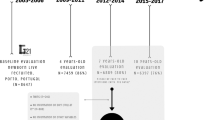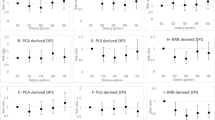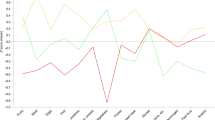Abstract
Background/Objectives:
The aim of this work was to identify dietary patterns based on reduced rank regression (RRR) and principal component analysis (PCA) and to evaluate the association of these patterns with the prevalence of childhood obesity.
Subjects/Methods:
A sample of 2317 toddlers and preschoolers from Greece (Growth, Exercise and Nutrition Epidemiological Study In preSchoolers) was used. In total, 12 food groups were used as predictors of RRR and PCA. Nutrients such as total fat, simple carbohydrate and fiber intake were used as response variables to apply RRR.
Results:
One factor/pattern was retained from RRR and PCA in order to ensure the comparability of the methods. The pattern derived from PCA was mainly characterized by consumption of fruits, vegetables, legumes, fish and seafood, grains and oils. This pattern explained 12.5% of the total variation in food groups. On the other hand, the pattern extracted from RRR was mainly characterized by reduced consumption of fruits, vegetables and legumes, and by increased consumption of sweets and red meat. The pattern derived from RRR explained 8.2% of the total variation in food groups. Simple and multiple logistic regression revealed that the pattern extracted from RRR is significantly associated with the prevalence of childhood obesity (OR=1.11, 95% CI: 1.00–1.28 for each unit increase of dietary pattern) as opposed to the pattern derived from PCA.
Conclusions:
The preferable technique to derive dietary patterns related to childhood obesity seems to be RRR compared with PCA.
This is a preview of subscription content, access via your institution
Access options
Subscribe to this journal
Receive 12 print issues and online access
$259.00 per year
only $21.58 per issue
Buy this article
- Purchase on Springer Link
- Instant access to full article PDF
Prices may be subject to local taxes which are calculated during checkout
Similar content being viewed by others
References
Anderson DR, Field DE, Collins PA, Lorch EP, Nathan JG (1985). Estimates of young children's time with television: a methodological comparison of parent reports with time-lapse video home observation. Child Dev 56, 1345–1357.
Aranceta J, Perez-Rodrigo C, Ribas L, Serra-Majem L (2003). Sociodemographic and lifestyle determinants of food patterns in Spanish children and adolescents: the enKid study. Eur J Clin Nutr 57 (Suppl 1), S40–S44.
Ballew C, Kuester S, Serdula M, Bowman B, Dietz W (2000). Nutrient intakes and dietary patterns of young children by dietary fat intakes. J Pediatr 136, 181–187.
Chagnon YC, Rankinen T, Snyder EE, Weisnagel SJ, Perusse L, Bouchard C (2003). The human obesity gene map: the 2002 update. Obes Res 11, 313–367.
DiBello JR, Kraft P, McGarvey ST, Goldberg R, Campos H, Baylin A (2008). Comparison of 3 methods for identifying dietary patterns associated with risk of disease. Am J Epidemiol 168, 1433–1443.
Dietz WH (2006). Sugar-sweetened beverages, milk intake, and obesity in children and adolescents. J Pediatr 148, 152–154.
Division of Public Health Surveillance Informatics. Centers for Disease Control Prevention (CDC) (2004) EpiInfo-Database and Statistics Software for Public Health Professionals.
Fung TT, McCullough ML, Newby PK, Manson JE, Meigs JB, Rifai N et al. (2005). Diet-quality scores and plasma concentrations of markers of inflammation and endothelial dysfunction. Am J Clin Nutr 82, 163–173.
Hedley AA, Ogden CL, Johnson CL, Carroll MD, Curtin LR, Flegal KM (2004). Prevalence of overweight and obesity among US children, adolescents, and adults, 1999–2002. JAMA 291, 2847–2850.
Hill JO, Wyatt HR, Reed GW, Peters JC (2003). Obesity and the environment: where do we go from here? Science 299, 853–855.
Hoffmann K, Boeing H, Boffetta P, Nagel G, Orfanos P, Ferrari P et al. (2005). Comparison of two statistical approaches to predict all-cause mortality by dietary patterns in German elderly subjects. Br J Nutr 93, 709–716.
Hoffmann K, Schulze MB, Schienkiewitz A, Nothlings U, Boeing H (2004). Application of a new statistical method to derive dietary patterns in nutritional epidemiology. Am J Epidemiol 159, 935–944.
Hoffmann K, Zyriax BC, Boeing H, Windler E (2004). A dietary pattern derived to explain biomarker variation is strongly associated with the risk of coronary artery disease. Am J Clin Nutr 80, 633–640.
Hu FB (2002). Dietary pattern analysis: a new direction in nutritional epidemiology. Curr Opin Lipidol 13, 3–9.
Jacques PF, Tucker KL (2001). Are dietary patterns useful for understanding the role of diet in chronic disease? Am J Clin Nutr 73, 1–2.
Kant AK (1996). Indexes of overall diet quality: a review. J Am Diet Assoc 96, 785–791.
Kaufman F (2005). Back away from the soda! Nearly half of all children between the ages of 6 and 11 drink sweetened sodas. Are these sugar-laden beverages partly to blame for the obesity epidemic? Diabetes Forecast 58, 42–45.
Lakkakula AP, Zanovec M, Silverman L, Murphy E, Tuuri G (2008). Black children with high preferences for fruits and vegetables are at less risk of being at risk of overweight or overweight. J Am Diet Assoc 108, 1912–1915.
Lim S, Zoellner JM, Lee JM, Burt BA, Sandretto AM, Sohn W et al. (2009). Obesity and sugar-sweetened beverages in African-American preschool children: a longitudinal study. Obesity (Silver Spring) 17, 1268–1268.
Linardakis M, Sarri K, Pateraki MS, Sbokos M, Kafatos A (2008). Sugar-added beverages consumption among kindergarten children of Crete: effects on nutritional status and risk of obesity. BMC Public Health 8, 279.
Lobstein T, Jackson-Leach R (2006). Estimated burden of paediatric obesity and co-morbidities in Europe. Part 2. Numbers of children with indicators of obesity-related disease. Int J Pediatr Obes 1, 33–41.
Manios Y (2006). Design and descriptive results of the Growth, Exercise and Nutrition Epidemiological Study In preSchoolers: the GENESIS study. BMC Public Health 6, 32.
Manios Y, Magkos F, Christakis G, Kafatos AG (2005). Twenty-year dynamics in adiposity and blood lipids of Greek children: regional differences in Crete persist. Acta Paediatr 94, 859–865.
Nanchahal K, Morris JN, Sullivan LM, Wilson PW (2005). Coronary heart disease risk in men and the epidemic of overweight and obesity. Int J Obes (Lond) 29, 317–323.
National Center for Health Statistics and The National Center for Chronic Disease Prevention Health Promotion (2000). CDC Growth Charts.
Nettleton JA, Steffen LM, Schulze MB, Jenny NS, Barr RG, Bertoni AG et al. (2007). Associations between markers of subclinical atherosclerosis and dietary patterns derived by principal components analysis and reduced rank regression in the Multi-Ethnic Study of Atherosclerosis (MESA). Am J Clin Nutr 85, 1615–1625.
Nicklas TA, Farris RP, Johnson CC, Webber LS, Berenson GS (1990). Food sources of nutrients: a tool for dietary management and health. The Bogalusa Heart Study. 1973–1983. Tulane Center for Cardiovascular Health: New Orleans, LA.
Nicklas TA, Webber LS, Srinivasan SR, Berenson GS (1993). Secular trends in dietary intakes and cardiovascular risk factors of 10-y-old children: the Bogalusa Heart Study (1973-1988). Am J Clin Nutr 57, 930–937.
North K, Emmett P (2000). Multivariate analysis of diet among three-year-old children and associations with socio-demographic characteristics. The Avon Longitudinal Study of Pregnancy and Childhood (ALSPAC) Study Team.. Eur J Clin Nutr 54, 73–80.
Northstone K, Emmett P (2005). Multivariate analysis of diet in children at four and seven years of age and associations with socio-demographic characteristics. Eur J Clin Nutr 59, 751–760.
Schulze MB, Hoffmann K (2006). Methodological approaches to study dietary patterns in relation to risk of coronary heart disease and stroke. Br J Nutr 95, 860–869.
Schulze MB, Hoffmann K, Kroke A, Boeing H (2003). ‘An approach to construct simplified measures of dietary patterns from exploratory factor analysis. Br J Nutr 89, 409–419.
Slyper AH (2004). The pediatric obesity epidemic: causes and controversies. J Clin Endocrinol Metab 89, 2540–2547.
Tucker KL (2007). Assessment of usual dietary intake in population studies of gene-diet interaction. Nutr Metab Cardiovasc Dis 17, 74–81.
Waijers PM, Feskens EJ, Ocke MC (2007). A critical review of predefined diet quality scores. Br J Nutr 97, 219–231.
Whitaker RC, Wright JA, Pepe MS, Seidel KD, Dietz WH (1997). Predicting obesity in young adulthood from childhood and parental obesity. N Engl J Med 337, 869–873.
Acknowledgements
We thank Vivian Detopoulou, Anastasia Anastasiadou, Christine Kortsalioudaki, Margarita Bartsota, Thodoris Liarigkovinos, Elina Dimitropoulou, Nikoleta Vidra, Theodoros Athanasoulis, Pari Christofidou, Lilia Charila, Sofia Tzitzirika and Christos Vassilopoulos for their contribution to the completion of the study. The GENESIS study was supported by a Research Grant from Friesland Foods Hellas.
Author information
Authors and Affiliations
Corresponding author
Ethics declarations
Competing interests
MY works as a part-time scientific consultant for Friesland Foods Hellas. The remaining authors declare no conflict of interest. The study sponsor had no interference in the study design, data collection or writing of the manuscript.
Rights and permissions
About this article
Cite this article
Manios, Y., Kourlaba, G., Grammatikaki, E. et al. Comparison of two methods for identifying dietary patterns associated with obesity in preschool children: the GENESIS study. Eur J Clin Nutr 64, 1407–1414 (2010). https://doi.org/10.1038/ejcn.2010.168
Received:
Revised:
Accepted:
Published:
Issue Date:
DOI: https://doi.org/10.1038/ejcn.2010.168
Keywords
This article is cited by
-
Comparing two methods for deriving dietary patterns associated with risk of metabolic syndrome among middle-aged and elderly Taiwanese adults with impaired kidney function
BMC Medical Research Methodology (2020)
-
Association of kidney function-related dietary pattern, weight status, and cardiovascular risk factors with severity of impaired kidney function in middle-aged and older adults with chronic kidney disease: a cross-sectional population study
Nutrition Journal (2019)
-
A traditional dietary pattern is associated with lower odds of overweight and obesity among preschool children in Lebanon: a cross-sectional study
European Journal of Nutrition (2019)
-
Association between diet quality, dietary patterns and cardiometabolic health in Australian adults: a cross-sectional study
Nutrition Journal (2018)
-
Dietary patterns are associated with attention-deficit/hyperactivity disorder (ADHD) symptoms among preschoolers in mainland China
European Journal of Clinical Nutrition (2018)



